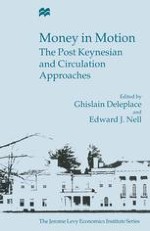1996 | OriginalPaper | Buchkapitel
Post Keynesian Fundism and Monetary Circulation
verfasst von : Mario Seccareccia
Erschienen in: Money in Motion
Verlag: Palgrave Macmillan UK
Enthalten in: Professional Book Archive
Aktivieren Sie unsere intelligente Suche, um passende Fachinhalte oder Patente zu finden.
Wählen Sie Textabschnitte aus um mit Künstlicher Intelligenz passenden Patente zu finden. powered by
Markieren Sie Textabschnitte, um KI-gestützt weitere passende Inhalte zu finden. powered by
Following the seminal writings of Sidney Weintraub, Post Keynesian economists have traditionally focused on the role played by wages and, more precisely, unit labor costs in both explaining inflationary pressures and in providing insights on the credit-driven nature of the money-supply process. Holding the view that money-supply growth is inextricably linked to the movement in money wages and employment, modern Post Keynesian writers, such as Basil Moore (1988, chapter 9), have made this Weintraubian view the cornerstone of their theory of endogenous money. Indeed, Paul Davidson (1988: 166–7) has gone as far as to suggest that this Post Keynesian theory of money can be interpreted as the modern counterpart of the ‘real bills’ doctrine widely espoused by the nineteenth-century endogenous-money theorists of the banking school.
